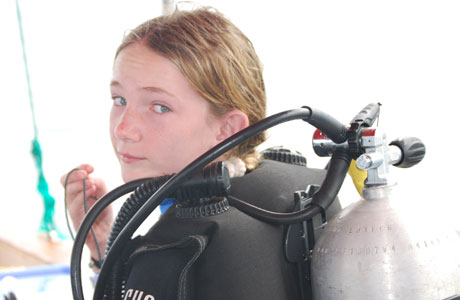Submerged in the dark waters around the Raja Ampat Islands, pilot Richard Wood watched the region's elusive “walking shark”—some of the vast biodiversity that makes the archipelago what Wood calls “some kind of Mecca” among scuba divers.
Wood, his wife and daughter, and another couple saw the bottom-dwelling wobbegong shark and enormous manta rays in the area during a 4,500-nautical-mile trip across Indonesia in the Pilatus PC-12 Wood owns with a partner. Upon his return from the three-week journey, Wood recalled the manta rays flying around the divers: “It's just like standing at the middle of an airport with airplanes flying patterns around you—but close,” he said.
Flying single-pilot, Wood dealt with weather challenges and navigated an airspace system in which he said he never saw another general aviation aircraft. The 1,700-hour pilot described a nation characterized by variety—of wildlife, cultures, and geography. The group saw komodo dragons in Flores, joined a seven-day-long funeral ceremony in Sulawesi, and enjoyed the hotels of Bali.
The Pilatus connected the group with isolated communities in Papua and Sulawesi, Wood said. In Central Sulawesi, the group landed at the remote Pongtiku Airport, which has no commercial service. “Dropping into the 5,000 ft elevation, 5,000 ft long airfield is like dropping into a secret valley,” Wood told AOPA in an email. “Lush and steep-sided with bullhorn-roofed houses in every direction as we joined a pattern for the Eastbound runway. Calls to 'Pongtiku traffic' elicited no response, so we landed without wind or altimeter information. A few security guys turned up to charge a landing fee but nobody seemed concerned that they weren't monitoring the radio.”
The travelers met locals who, in spite of language barriers, were very welcoming, he said. The Toraja people, who have extensive seven-day-long funeral rites, welcomed the group for one of the elaborate ceremonies, Wood added. The tribe hosts hundreds of people for the rite, which are held months after the person's death, to give family time to plan.
The trip also brought Wood and his companions to such varied sites as the Buddhist temple of Borobudur in central Java and the hotels of Bali.
Indonesia, an archipelago of more than 17,000 islands, is accessible by a large network of airports. Wood chose to visit the nation because his partner had wanted to take the airplane across Asia. So the Woods picked up the airplane in Singapore and flew a U-shaped flight plan across the islands and north to Manila, Philippines. Before the flight, they looked at the most interesting things to visit, and found nearby airports in almost every case—a presence Wood attributes to the longtime military presence in the former dictatorship.
The airports were well-organized, Wood said, but he found the controllers less than helpful. Many spoke poor English, and they offered little help with navigating the weather—an important factor in planning flights during the region's rainy season. Wood compensated for uncertainty with ample fuel reserves and a philosophy he has developed from flying his aircraft in countries around the world.
“You're the pilot,” he said, “so you can control the situation and understand when someone doesn't understand you and keep on asking the question. … Then it becomes a great way to get around.”









